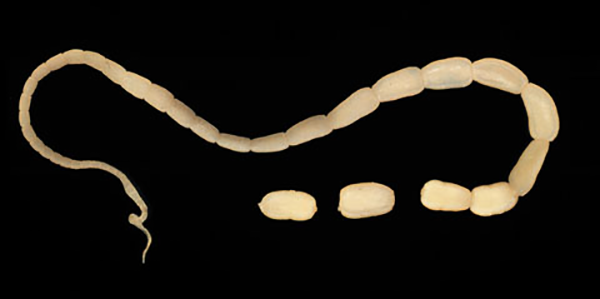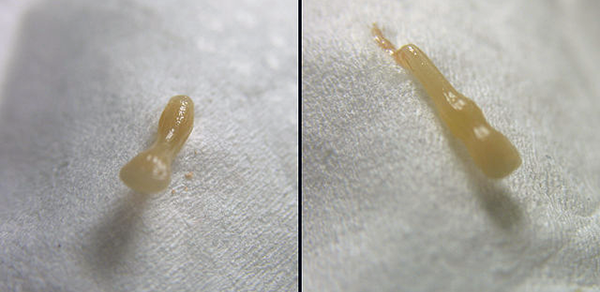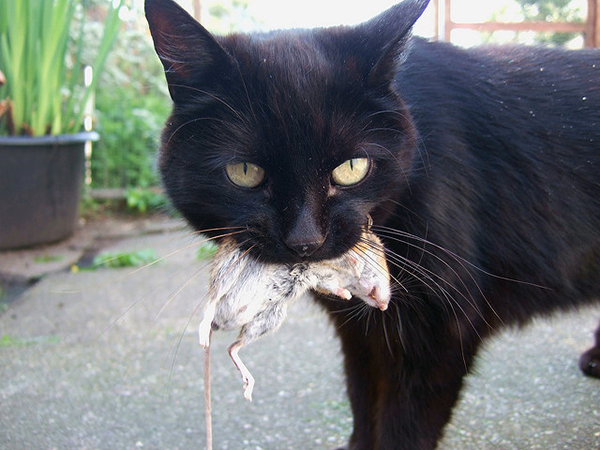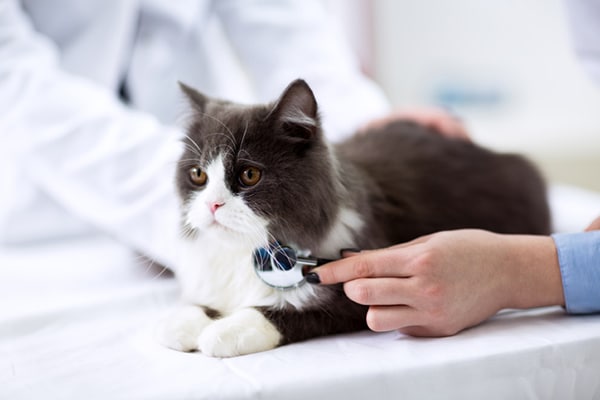I remember the first time I encountered tapeworm in cats. It was a cool autumn day when I was about 14, and my cat, Pollux, was sitting on top of me getting some love. He turned around to show me his bottom and there were a bunch of rice grain-looking things, and they were MOVING! “Eeew!” I shouted, and promptly ejected him from my lap.
My mother informed me that those were tapeworm segments, and she went off to the vet to get some medicine to kill the nasty little buggers.

Tapeworms are quite common in cats, and I’m sure you’ve seen them before. Here’s some information about what they are, where they come from and how to treat them.
Tapeworms are classified as cestodes
Cestodes are a family of parasitic flatworms. They’re called flatworms because they are (duh) flat, ribbon-like worms, as opposed to roundworms such as earthworms and hookworms. The most common species of tapeworm to infect cats is Dipylidium caninum, or the dog tapeworm.
Your cat gets tapeworms because of fleas
Even if you don’t see a single flea on your cat, he must have ingested a flea to develop tapeworms. That’s because fleas are the intermediate host: that is, the tapeworm is unable to complete its life cycle without fleas.

The first step of infection: Hooking in
After your cat eats a flea, the stomach acids digest the flea and leave the tapeworm eggs floating free in the intestines. As they develop, they grow hook-like mouth parts, which attach to the walls of the intestines. This head and its hooks are called a scolex.
The second step: Growing
As adult tapeworms mature, they produce individual segments that are basically sacs full of eggs. Those break off and pass through the intestines and out with the feces. Those segments are called proglottids, and they’re those disgusting rice-grain things you’ll see moving around in your cat’s poop or near his anus. Adult tapeworms can grow to several inches in length. Sometimes if a cat develops a tapeworm in his stomach, he could vomit it up: Extra points for grossness, kitty!

Treating tapeworm in cats
Many products on the market supposedly treat tapeworms in cats, but the most effective treatment is a broad-spectrum cat dewormer, which is available only through a veterinarian. It can be given as a tablet or an injection. Usually you won’t see any worms coming out of your cat after the dewormer is given, because the worms die and are then digested in the intestine. You’ll also want to de-flea your home by cleaning all bedding, furniture, and carpets in order to prevent reinfection.
There’s another kind of tapeworm that can infect cats
Cats can get infected with the tapeworm species Taenia when they eat infected mice, birds or rabbits. Those animals are the intermediate hosts of Taenia The dewormer you get from your vet will kill Taenia tapeworms, too. But if your cat keeps eating prey, he’ll get reinfected and start passing tapeworm segments in six to eight weeks.

Can tapeworms infect humans?
It’s very, very unlikely, because a person would actually have to eat a flea in order to get infected with tapeworms from a cat. That said, there are tapeworms that infect humans, usually as a result of eating undercooked pork or beef.
A word on home remedies for tapeworm in cats
Yes, there are also lots of folk remedies for treating tapeworms, but none of them is effective. Believe me, I’ve tried them. Some are outright toxic, too: I’ve seen people advise giving garlic to a tapeworm-infected cat, but garlic causes potentially fatal anemia in kitties, so please, just don’t.

Preventing tapeworms
Because a cat must ingest fleas or eat prey in order to develop tapeworms, the most effective thing you can do to keep your cat from getting them is to use regular flea prevention. Keep your cat indoors so he doesn’t eat mice, birds, or rabbits. Monthly flea control products from your veterinarian are very important, especially if you live in a heavily flea-infested area.
What other questions do you have about tapeworms in cats? Please ask them in the comments!
Thumbnail: Photography by didesign021/Thinkstock.
Read more about cats and health care on Catster.com:








